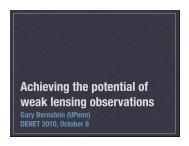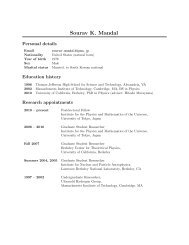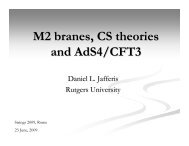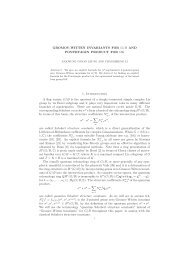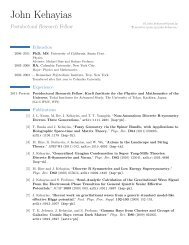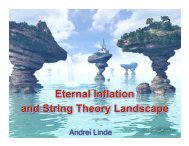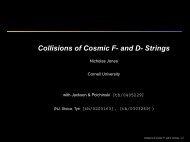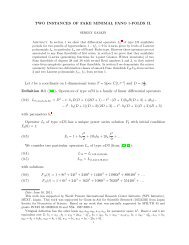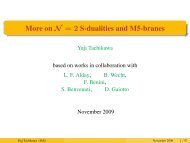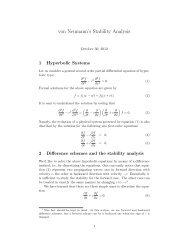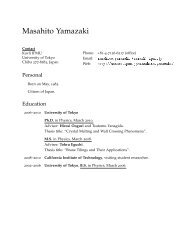STUDY SUMMARY - IPMU
STUDY SUMMARY - IPMU
STUDY SUMMARY - IPMU
Create successful ePaper yourself
Turn your PDF publications into a flip-book with our unique Google optimized e-Paper software.
<strong>SUMMARY</strong> REPORT<br />
WIDE FIELD FIBER-FED OPTICAL<br />
MULTI-OBJECT SPECTROMETER (WFMOS)<br />
Focal ratio degradation (FRD), the third major source of throughput error, is a measure of<br />
how well the fiber preserves the angular distribution of the input light. FRD is often hard to<br />
quantify and depends to a large extent on fiber geometry (core diameter and core/cladding concentricity)<br />
variation and details of the routing (bends, twists, stresses on fiber). Proper NA<br />
matching between the telescope, fiber, and spectrometer is critical to avoid losses from overfilling<br />
or under-filling the fiber or the spectrometer. Fiber mismatch at the connector interface can<br />
also introduce FRD. LNA has devoted substantial effort to understanding and minimizing losses<br />
from FRD. Figure 3.11-2 shows some early results.<br />
Besides the above major contributors there are other loss terms. Fresnel losses (~4%) at both<br />
ends of the fiber can be substantially minimized (to ~1%) with broadband anti-reflective<br />
(BBAR) coatings. This is relatively easy to do at the slit-block end. AR coating fibers at the positioner<br />
end presents logistical challenges; therefore, those ends will be left uncoated. There are<br />
also losses (evanescent field decay) from bending and twisting of fibers. We have allocated 5%<br />
losses due to these effects.<br />
The fibers at the positioner end are placed and bonded in a custom ceramic ferrule that is<br />
mounted to the actuator. As the fiber is moved, it twists and coils, either of which can cause<br />
FRD. To understand this, 15 mock-ups of the actuator assembly were built to simulate articulation<br />
of fiber in the same manner as the proposed design. Test results indicate that twisting does<br />
not appear to induce an increase in FRD.<br />
To present light to the spectrometer, 800 fiber tips will be lined up in a linear array with a<br />
pitch of 230 μm. Each “slit block” will contain 80 fibers, and 10 slit blocks will be assembled<br />
end-to-end to build one “slit” for each of the spectrographs. In risk-reduction activities, 80 rows<br />
of fibers were epoxied (with EPOTEK 301) to quartz blocks. Several PTFE blocks were used to<br />
hold the position of the fibers accurately during epoxy curing. Once the fibers were bonded, the<br />
“slit block” was lapped and polished. For WFMOS, an additional cover plate, with BBAR coating<br />
on one side and index-matching gel on the other side, will be placed against the slit block<br />
surface to minimize Fresnel losses.<br />
To protect the fibers from handling and environment, they are enclosed first in a protective<br />
tube and then are grouped into the segmented tubes which act as a protective conduit. The filled<br />
volume of the segmented tubes is calculated to prevent any crushing of the fibers.<br />
As mentioned earlier, the fiber cables are separated into two sections:<br />
• The short, approximately 5-m, cables go from the positioners to the top of the PFU<br />
through a strain relief box. The strain relief box is designed to protect the fibers from the<br />
motions of the telescope. This short section stays with the PFU and instrument.<br />
• The long, approximately 55-m, cables run from the connectors on top of the PFU all the<br />
way to the spectrograph located in the adjacent room. Part of this long cable—from the<br />
spectrograph to the telescope structure—is permanent.<br />
The remaining section is connected to the PFU during instrument operation and stored away<br />
(tied to the telescope structure) when not in use.<br />
3.12 Spectrograph<br />
Our WFMOS spectrograph subsystem design comprises a set of three identical generalpurpose<br />
spectrographs capable of carrying out all four required surveys (see Section 2) as well as<br />
offering the flexibility for many other types of observation. The spectrograph requirements and<br />
basic parameters are summarized in Tables 3.12-1 and 3.12-2.<br />
45



